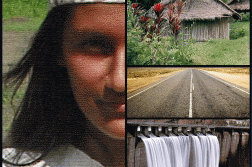When it comes to environmental conservation and sustainable development initiatives in tropical forests, indigenous peoples are key players. They have been described often as either conservationists or destroyers of biodiversity. The position adopted on this matter is important because it guides the design and implementation of conservation strategies. The central question about what makes indigenous peoples conserve or degrade biodiversity, however, has posed a significant challenge, particularly in light of widespread trends such as cultural change, market expansion, and greater diversification of livelihoods.
The reasons why indigenous communities end up degrading or conserving natural resources are addressed in a comprehensive yet accessible manner in this book, filling a critical gap in current knowledge about the socioeconomic drivers of biodiversity loss, and the rise of community-based conservation, using the hunting trends and conservation efforts of the Wachiperi for this analysis.
This is a recommended book for any person looking to understand how indigenous peoples interact with their local environment. Readers could greatly benefit from the lessons provided in this book about achieving both socioeconomic development and biodiversity conservation by engaging indigenous communities in a sustainable manner.
Specific areas where readers will develop greater knowledge and awareness include:
– The way indigenous environmental behavior changes in time
– The reasons behind the changes in indigenous conservation behavior
– The biological, cultural and socioeconomic dimensions of environmental behavior
– The interplay between individual and group interests among indigenous groups
– The importance of leadership in the definition of environmental attitudes
– How historical processes shape present environmental behavior
– The current struggles of indigenous peoples living in tropical forests
– The effect of regional socioeconomic changes on village dynamics
– How to achieve environmental conservation and sustainable development
“Hunting Practices of the Wachiperi: Demystifying Indigenous Environmental Behavior,” by Rodolfo Tello. Available in hardcover, paperback and digital editions.
You can order the second edition of the book at these and other stores:
A sample chapter is included next:
Introduction
Becoming the first indigenous community entrusted by the Peruvian government with the responsibility of managing a natural protected area was not something that happened by accident. It was the result of a long and evolving process, where the courage of the Wachiperi of Queros to undertake and succeed in this novel initiative took many people by surprise. The experience of the Wachiperi is one of survival, innovation and hope. It is also an example that targeting both environmental conservation and socioeconomic development simultaneously is not only desirable but also achievable, if we first take the time to understand what drives indigenous environmental behavior.
In 2008, the leader of the community of Queros signed a contract with the Peruvian government to manage a conservation concession for a renewable period of forty years. This event was the result of a partnership between an indigenous community and an environmental organization. It provided people from Queros with the required technical and financial support to embark on this environmental initiative. The adoption of this strategy by the Wachiperi was a clear indication of their active engagement in natural resource conservation. However, this was not always the case. In the last few decades, there were also times when their harvesting activities led directly to the degradation of the local natural resources. As such, the experience of the Wachiperi also provides a great example of the variation through time of indigenous environmental behavior.
The impact of indigenous peoples on tropical biodiversity through animal hunting has been a key area of discussion. The analysis of the hunting practices of the Wachiperi provides insights into the larger debate about the relationship between indigenous peoples and biodiversity in tropical forests. Key questions explored in this book are: What explains the variation in the levels of hunting intensity among the Wachiperi? To what extent do regional historical processes help explain the current intensity of hunting? How has the social division of labor shaped their hunting practices? How important are cross-cultural factors in the establishment of their present levels of hunting? What are the most significant factors influencing their current levels of hunting? What are the implications of changes in the intensity of hunting for both biodiversity and the living conditions of the Wachiperi?
The community of Queros is located within the Kosñipata District of the Cusco Region in Peru, in the Amazonian multiple use zone of Manu National Park, a place with one of the highest concentrations of biodiversity on earth. The weather in the area near Queros is warm and humid, with abundant rain throughout the year, particularly between November and March.
The Wachiperi have lived in the Kosñipata Valley for about a thousand years (Llosa and Nieto 2003). They alternated periods of conflict and peace with other indigenous groups in that region. They also traded coca leaves and ornamental feathers with the Incas. Beginning in the middle of the sixteenth century, the Spaniards started establishing agricultural plantations in the area, occasionally exchanging products with the Wachiperi (Califano 1985). Despite these exchanges, the Wachiperi did not establish permanent relationships with members of Western society until the middle of the twentieth century, when their interactions with outsiders brought about the transmission of external diseases, particularly smallpox, which killed approximately 65% of the Wachiperi population (Pinasco 2002: 13). These massive population losses had dramatic affects to the Wachiperi. One notable change was the forced resettlement into a Baptist mission that had recently been established in the area. The missionaries invited the surviving Wachiperi to live in the mission offering them various kinds of support and medical attention. This relocation was a major event for the Wachiperi, who in the span of a few years saw their lives deeply transformed.
The fact that the Wachiperi maintained a relatively independent way of life until the 1950s, however, placed them in a different position from most groups in the Amazon region. For the most part, they were severely disrupted by colonization since the earlier stages of Spanish occupation in the sixteenth century (Lathrap 1973).
The establishment of closer relationships between the Wachiperi and members of Western society created significant changes in their livelihoods. Shortly after moving into the Baptist mission, the Wachiperi adopted market-oriented activities in addition to their customary practices of subsistence. Their interactions with missionaries, along with the increasing number of settlers coming to the Kosñipata Valley in the following decades, created significant changes in the Wachiperi lifestyle. This posed a significant challenge to find ways to combine their expectations for socioeconomic development [1] with the conservation of the natural resources. Conserving the local forests was important for their subsistence, as was their growing need for market products, which were gradually introduced into their way of life.
As a result of these changes, some activities like hunting experienced a significant reduction during the last five decades. Other activities experienced intensification, such as agriculture. Currently, a large portion of the community’s agricultural production is intended for sale in Pillcopata, a nearby town and the political capital of the Kosñipata district. Pillcopata is mostly inhabited by former settlers who came to the area about three decades ago.
The current population of Queros is approximately sixty people, which represents a tiny fraction of the Wachiperi population before the middle of the twentieth century. People from Queros frequently visit Pillcopata, where they have relatives and friends. Some members of Queros even live in Pillcopata on a full-time basis. Accordingly, the community of Queros should be understood not as a territorially bounded village, but mainly as a network of people whose activities transcend a single physical space.
Pillcopata is located about seven miles away from Queros, and is connected by a single dirt road. Queros residents make frequent trips to Pillcopata, which takes about two hours on foot. Buses run three times a week from Pillcopata to Cusco, the closest city in the region, on a trip that takes almost nine hours. Although Queros is the community where most Wachiperi are currently concentrated, some Wachiperi families live in other indigenous communities, adding another thirty individuals. However, for practical reasons, mention of the Wachiperi in this book is limited only to people belonging to this indigenous group who are members of Queros.
Changes in the hunting practices of the Wachiperi are significant because hunting used to be critical to their subsistence in the ancestral way of life. Today, the intensity of hunting in Queros is significantly lower than the hunting levels they had around the middle of the twentieth century. Their current harvest of meat is for subsistence, to celebrate festivities in the community, for recreational purposes, and to prepare meals for their guests. The main animals hunted are small and medium-sized terrestrial mammals like armadillos, peccaries, tapirs, paces, deer, and capybaras. Birds are also hunted on a regular basis, including six’s guan, white-throated dynamo, and common piping guan. In addition to hunting, other contemporary activities include agriculture, logging, gathering, fishing, raising chicken, tourism, conservation, and working as salaried employees.
The community of Queros provides unique insights into the contemporary behavior of indigenous groups, such as their involvement in processes different from the ancestral practices of subsistence commonly associated with indigenous communities. These new processes include the management of a conservation concession, the establishment of a partnership with a regional environmental organization, their engagement in community-based tourism activities, and commercially-oriented agriculture, among others. The existence of members with college education working on these projects was another factor that illustrates the extent that higher education can make a difference in the activities undertaken by indigenous communities.
Unlike positions that perceive indigenous peoples as natural conservationists (Clay 1988: 4; Posey 1998: 115; Warren 2001: 453; Meggers 1971: 2) or as threats to tropical biodiversity (Terborgh 2000: 1359; Redford and Sanderson 2000: 1362; Robinson et al. 1999: 595; Oates 2000: B6), the analytical approach adopted in this book recognizes indigenous peoples as adaptive agents whose environmental behavior varies according to their specific conditions (Balée and Erickson 2006: 12; Chicchon 1993: 15;Berkes and Folke 1998: 10). To analyze the factors that encourage indigenous communities either to pursue sustainable livelihoods or to adopt practices leading to environmental degradation, relevant publications identified different factors affecting indigenous environmental behavior in tropical forests. I grouped these contributions into biological models, socioeconomic approaches, and cultural explanations, along with the historical processes associated with particular settings.
The way I address this general body of literature is to acknowledge that all the factors identified as influential to indigenous environmental behavior may be important in some cases but not in others. However, since the relevance of each potentially influential factor varies from one setting to another, which has not been adequately accounted for, this situation required adopting an approach based on a more flexible understanding of the issues surrounding the variation in environmental behavior. Thus, I searched for an analytical framework capable of (i) exploring the potential of multiple factors identified as influential in different geographical and cultural contexts, (ii) allowing for the identification of the most relevant factors influencing environmental behavior and the way they interact in each particular research setting, and (iii) articulating different levels of analysis to understand the interplay between multiple influential factors within a historical perspective. I found that such an approach is provided by the ethnographic application of the root-cause analysis methodology (Steadman-Edwards 1998; Wood et al. 2000). This methodology offers the means to identify and differentiate between the root causes and the proximate causes of variation in environmental outcomes and processes. Root cause analysis also provides a high level of flexibility when identifying the most influential aspects of environmental behavior, according to the particular conditions of each research setting. Based on this approach, I examined the different factors that the literature identified as potentially influential and evaluated their local relevance among the Wachiperi, within the context of the historical processes and events associated with this group.
While conducting this study, I focused on the variation with the intensity of the hunting practices of the Wachiperi since the middle of the twentieth century. Hunting intensity is understood here as an operational term that indicates the level of pressure on forest animals, defined by the frequency of hunting and the number of animals hunted. The lack of baseline information did not allow for direct comparisons, so I relied on reconstructions based on the recollection of the Wachiperi about the intensity of their hunting practices in different historical moments, and the identification of patterns in their hunting behavior.
At a more general level, this book provides analytical insights into the socioeconomic and environmental processes underlying the relationship between indigenous peoples and tropical biodiversity, addressing crucial issues for members, friends, and allies of indigenous communities, environmental anthropologists, conservation scientists, interdisciplinary practitioners, academics, students, and people interested in socially sustainable environmental conservation in general, particularly those involved in the design and implementation of conservation policies and programs.
Notes:
[1] The term “development” is understood here as the pursuit of improvements in the living conditions of a population based on their own criteria. This approach is related to the idea of “community-driven development,” which refers to processes where “community groups initiate, organize, and take action to achieve common interests and goals” (Narayan 1998: 103), as well as to the idea of “ethnodevelopment,” which refers to the “sense of ethnic identity, close attachment to ancestral land, and capacity to mobilize labor, capital, and other resources for shared goals” (Van Nieuwkoop and Uquillas 2000: 3).
[End of Sample Chapter]
“Hunting Practices of the Wachiperi: Demystifying Indigenous Environmental Behavior.” Second edition, available in hardcover, paperback and digital formats. Order the second edition of the book here:
For additional information, visit https://www.amakella.com



